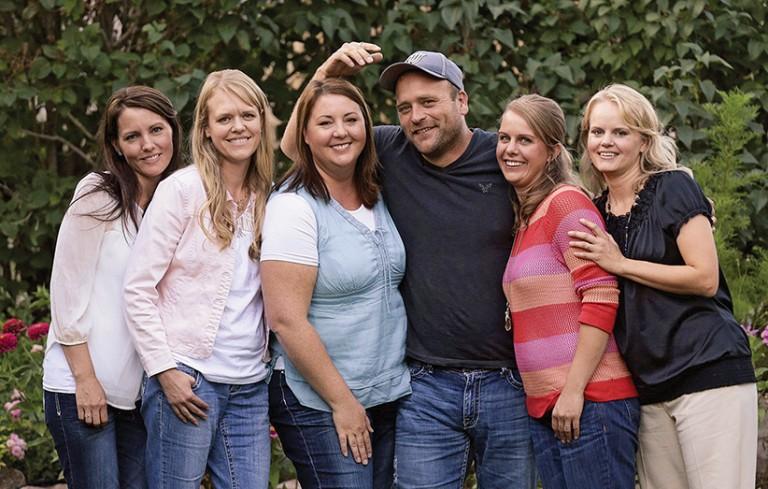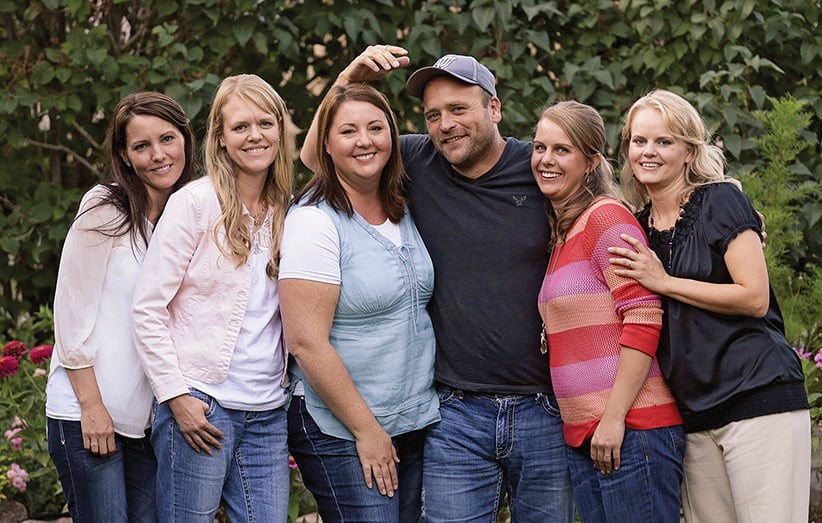Why embracing our inner polygamist is good for marriage
This book explores what humans have won, and lost, with the decline of polygamy

Brady Williams poses with his wives, from left to right, Paulie, Robyn, Rosemary, Nonie, and Rhonda, outside of their home in a polygamous community outside Salt Lake City. The Williams are among an estimated 15,000 independent polygamists in the West that don’t belong to an organized fundamentalist Mormon church. (Rick Bowmer/AP)
Share

“It is strange,” agrees David Barash, when he’s asked if an evolutionary biologist like him ever tires of having to continually point out the obvious about humanity’s essential polygamy. Given the record, from the hundreds of wives collected by Egyptian pharaohs to biblical patriarchs with their handful to the number of people signed on to the Ashley Madison adultery site, “you’d think we’d be aware of our biological inclinations,” says the author of Out of Eden: The Surprising Consequences of Polygamy.
That’s the sort of statement that has often made Barash a controversial figure to the U.S. Christian right—one conservative writer included him in a list of “the 101 most dangerous academics in America”—but Barash is not on an anti-religious campaign. “Most people are aware of the conflict between our biological urges and our cultural/religious prohibitions, but draw the wrong conclusions. The more people think monogamy is ordained by nature—or God—the more they are likely to think sexual temptation means they are evil people, or that they simply married the wrong spouse.”
It also tends to keep the focus on male misbehaviour. Barash means polygamy in its exact sense—multiple sexual and/or reproductive partners, whether serially or all at once—rather than the way the word is commonly used, as a synonym for polygyny (one man, many women). The confusion of terms is understandable, Barash notes, given that anatomy (10 women and one man can have 10 times the reproductive success of one woman and 10 men) and cultural encouragement (it’s men who establish harems) mean polygyny is virtually the only overt kind of polygamy familiar to us. But polyandry—one woman, many men—is a fact of human life too, succinctly captured in geneticists’ findings that up to 10 per cent of the children who call the adult male in their lives “father” are mistaken, biologically speaking.
The historical/anthropological case for polygyny—all those pharaohs, sultans and Old Testament patriarchs—is briskly set out, more a reminder than breaking news. In 1998, the University of Wisconsin surveyed more than a thousand societies and found that only 186 were monogamous. (Officially, that is: adultery exists in all times and places.) Some 453 cultures had occasional open polygyny, and in 588 more it was quite common, while just four featured recognized polyandry. The biological case, however, is more nuanced, particularly when it comes to polyandry.
Sexual dimorphism—the differences in size between males and females of the same species—is highly correlated with polygamy: human males are consistently larger than females—a marker for “moderate polygyny.” Elephant seal bulls, weighing in excess of 2,500 kg, are three times the size of cows, predictive of extreme polygyny: as it turns out, four per cent of the bulls sire 85 per cent of the calves. The bulls use size and strength—violence, in other words—to drive off competitors, the same (unconscious) reproductive strategy of human history’s most prolific fathers: Giocangga, founder of what eventually became China’s Qing dynasty, is the ancestor of 1.6 million men alive today.
Thus, “a Martian anthropologist come to examine homo sapiens would see the polygyny from outer space,” says Barash, “but the polyandry would appear only on closer look.” Human females have had to be subtler in their reproductive strategies, a physical fact reflected in their biological evolution. Women are unusual among mammals, and especially our close primate kin, in their concealed ovulation (making it virtually impossible for jealous harem-builders to keep an eye on them during every possible reproductive moment); they are equally unusual in lacking the sort of behavioural estrus cycle that leaves them in thrall to their hormones (meaning they can be choosy in mate selection); and while the evolutionary purpose of the female orgasm is still hotly debated, one of its effects is to “reassure her partner by providing confidence that she will be sexually faithful, while giving her the opportunity to be exactly the opposite,” writes Barash in Out of Eden.
There are advantages and disadvantages for both sexes in either system—which is why both continue strong among humans. The upside for the elephant seal bulls among men is obvious; women in polygynous cultures have access to those powerful genes, an inheritance they get to pass on to their offspring. Polyandry, although covert and dangerous for all involved, given alpha male sexual jealousy, provides otherwise denied-access males with a chance at reproduction. As for women, “there is no one-size-fits-all polyandry explanation,” says Barash. The reasons include increased access to resources, insurance (a ready-to-hand new mate should anything happen to the first) and “what I think is the most important: pure sexual attraction.” That’s “a powerful biological urge on its own,” adds Barash.
So where on earth did monogamy come from, and why do humans seem to be on their way to a new species status quo, even if it may be forever honoured more in the breach than in the observance? “Monogamy is actually a very good deal for men,” Barash says, far more than it is for women. The genetic evidence shows that until the first agricultural settlements began about 10,000 years ago, most women managed to have offspring, but very few men contributed to the gene pool, indicating very large-scale harem formation. Since then, the rise of monogamy—“there’s a theory that it came from ‘big men’ scaling down their harem-building in exchange for social peace—means more and more males have passed on their genes. For a woman the payoff comes in greater paternal investment in her children, and not some other woman’s. (There is considerable evidence that monogamy is the best system for child raising.) Perhaps surprisingly for an evolutionary biologist, a profession given to determinism, Barash is sanguine and even approving of the development. “Our inclinations are just that,” he says. “We can opt for different and better. We are not prisoners of our biology.” In short, for a species both polygynous and polyandrous, we can be oddly monogamous.